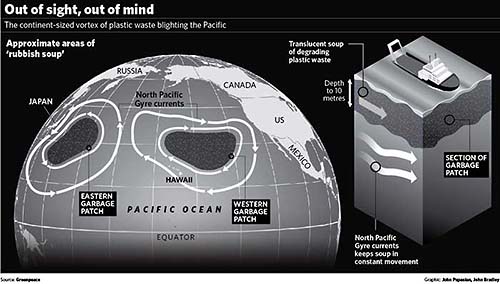This is disgusting, and shows just how primitive we still are. Full article here.

A “plastic soup” of waste floating in the Pacific Ocean is growing at an alarming rate and now covers an area twice the size of the continental United States, scientists have said.
The “soup” is actually two linked areas, either side of the islands of Hawaii, known as the Western and Eastern Pacific Garbage Patches. About one-fifth of the junk – which includes everything from footballs and kayaks to Lego blocks and carrier bags – is thrown off ships or oil platforms. The rest comes from land.
Mr Moore, a former sailor, came across the sea of waste by chance in 1997, while taking a short cut home from a Los Angeles to Hawaii yacht race. He had steered his craft into the “North Pacific gyre” – a vortex where the ocean circulates slowly because of little wind and extreme high pressure systems. Usually sailors avoid it.
He was astonished to find himself surrounded by rubbish, day after day, thousands of miles from land. “Every time I came on deck, there was trash floating by,” he said in an interview. “How could we have fouled such a huge area? How could this go on for a week?”
Mr Moore, the heir to a family fortune from the oil industry, subsequently sold his business interests and became an environmental activist. He warned yesterday that unless consumers cut back on their use of disposable plastics, the plastic stew would double in size over the next decade.
Mr Moore said that because the sea of rubbish is translucent and lies just below the water’s surface, it is not detectable in satellite photographs. “You only see it from the bows of ships,” he said.
According to the UN Environment Programme, plastic debris causes the deaths of more than a million seabirds every year, as well as more than 100,000 marine mammals. Syringes, cigarette lighters and toothbrushes have been found inside the stomachs of dead seabirds, which mistake them for food.
Plastic is believed to constitute 90 per cent of all rubbish floating in the oceans. The UN Environment Programme estimated in 2006 that every square mile of ocean contains 46,000 pieces of floating plastic,
Dr Eriksen said the slowly rotating mass of rubbish-laden water poses a risk to human health, too. Hundreds of millions of tiny plastic pellets, or nurdles – the raw materials for the plastic industry – are lost or spilled every year, working their way into the sea. These pollutants act as chemical sponges attracting man-made chemicals such as hydrocarbons and the pesticide DDT. They then enter the food chain. “What goes into the ocean goes into these animals and onto your dinner plate. It’s that simple,” said Dr Eriksen.
